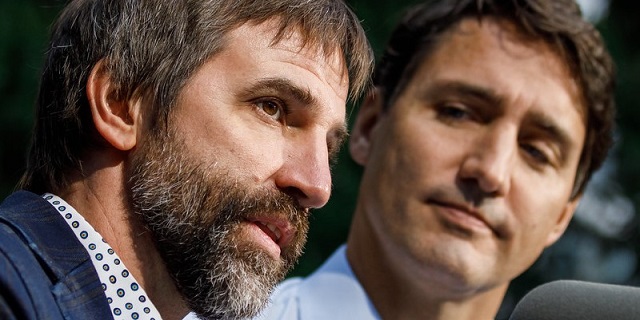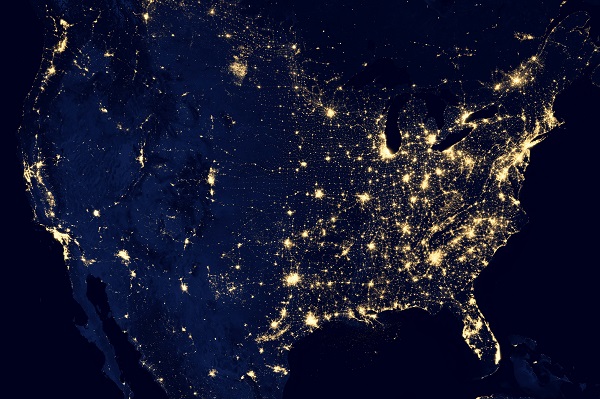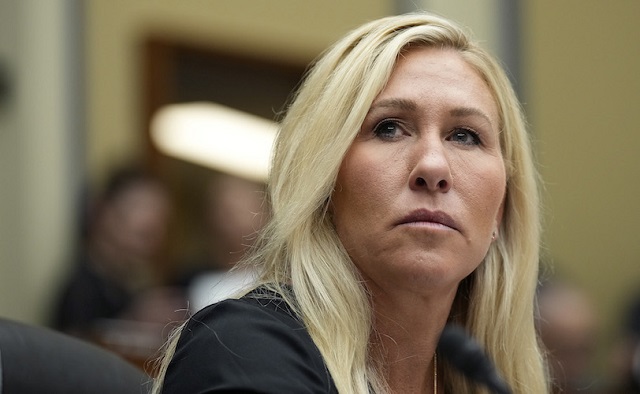Economy
Trudeau Government Capping the Canadian Economy (and Energy Industry) Just to Impress International Agencies

From EnergyNow.ca
By Kasha Piquette
The incoming Trump Presidency has promised to “unleash American energy” with plans to “free up the vast stores of liquid gold on America’s public land for energy development.” This week, the Trudeau government unveiled the draft details of its plans for a cap on greenhouse gas emissions from the Canadian oil and gas sector. These proposed regulations would cap all greenhouse gas emissions equivalent to 35 percent below levels in 2019 with the lofty goal of achieving a 40-45 percent reduction by 2030.
It is a plan that the province of Alberta and others contend would be a cap on production and cause elevated prices for consumer goods across Canada, cost up to 150,000 jobs and reduce national GDP by up to C$1 trillion ($720 billion).
These proposals would make Canada the only oil and natural gas-producing country to attempt an emissions cap on such a scale. The regulations propose to force upstream oil and gas operations to reduce emissions to 35 percent less than they were in 2019 by 2030 to 2032. Notably, while hydrocarbon production increased from 2019 to 2022, Canadian emissions from the sector declined by seven percent.
Perhaps significantly, and much to the apparent annoyance of Alberta’s Premier, the Federal announcement was made slightly ahead of the UN COP29 Climate Summit in Azerbaijan. Per the Paris Agreement, each country submits its climate ambitions to UN as National Determined Contributions (NDCs). However, the federal government has also passed the Net Zero Accountability Act, which, by December 1st, 2024, could require even more aggressive reduction targets for 2035. Does this mean that the federal government may be positioning itself to announce even more ambitious emission targets – all to be announced at that conference?
It is unclear whether, how and in what form, the emissions cap will come into effect. With the next federal election slated for late October 2025 and polls that show the current Liberal-NDP coalition government to be far behind the opposition Conservatives, the federal carbon tax and the proposed emission cap have an uncertain future.
Other business interests have voiced concerns about Canada’s increasingly discordant, incoherent climate policies and regulations, which have caused the Canadian oil and gas sector to be at a competitive disadvantage in the global energy market. Clearly, Alberta considers that the Federal government has, once again, overstepped its constitutional bounds with the proposed emissions cap and, along with its victorious Supreme Court challenge against the Impact Assessment Act, has vowed to launch more court challenges. Alberta and other Provinces have contended that, with regional exemptions, the federal carbon tax is being applied unfairly as a patchwork of standards with Alberta, New Brunswick, Saskatchewan, Ontario and Nova Scotia, and the opposition Conservative party, mounting a growing chorus against the Liberal government’s broader price on carbon. By contrast, the proposed regulations for an emissions cap have been aimed specifically at one industry sector – one that is largely concentrated in western Canada.
Meanwhile, Canadian oil production, aided by the new export capacity of the TransMountain Pipeline completed this year, has grown to a record 5.1 million barrels per day making Canada the prime (60%) source of US crude oil imports in 2023. Meanwhile, the industry has been engaged in considerations for the potential development of carbon capture and storage (CCS) to trap greenhouse gasses underground. However, this untested technology would cost billions, needs to be proven on a larger scale and requires industry cooperation combined with all levels of government support.
The Federal announcement, and the hostile reaction from Alberta and possibly other oil-producing provinces, mean that once again, Canadian investment in the oil and gas sector will be confronted with ever more uncertainty as they encounter time-consuming court challenges. These competing political agendas ensure that major Canadian investment decisions will, once again, be deferred while other international jurisdictions race to develop their hydrocarbon export capabilities, investments that are unencumbered by any emissions caps.
Canadians need to consider carefully how these policies and debates are affecting our energy security and standard of living as Canada. In addition to carbon pricing, Canada has already promulgated regulations for EV mandates in the transportation sector, policies that have required tens of billions in subsidies. It has also introduced the complex clean fuel standard and the proposed national clean electrical standards. These policies are affecting not just Canada’s productivity, GDP and exports. By attacking the Western provinces, Ottawa is unnecessarily creating regional tensions and a less politically stable federation. We need to think about how co-operative federalism can be re-established in ways that account for the basic needs of all Canadians – and not just accommodate arbitrary targets for emissions designed to impress international agencies.
Kasha Piquette is an Alberta-based strategic energy advisor and a former Deputy Minister of Alberta Environment and Protected Areas.
Business
The world is no longer buying a transition to “something else” without defining what that is

From Resource Works
Even Bill Gates has shifted his stance, acknowledging that renewables alone can’t sustain a modern energy system — a reality still driving decisions in Canada.
You know the world has shifted when the New York Times, long a pulpit for hydrocarbon shame, starts publishing passages like this:
“Changes in policy matter, but the shift is also guided by the practical lessons that companies, governments and societies have learned about the difficulties in shifting from a world that runs on fossil fuels to something else.”
For years, the Times and much of the English-language press clung to a comfortable catechism: 100 per cent renewables were just around the corner, the end of hydrocarbons was preordained, and anyone who pointed to physics or economics was treated as some combination of backward, compromised or dangerous. But now the evidence has grown too big to ignore.
Across Europe, the retreat to energy realism is unmistakable. TotalEnergies is spending €5.1 billion on gas-fired plants in Britain, Italy, France, Ireland and the Netherlands because wind and solar can’t meet demand on their own. Shell is walking away from marquee offshore wind projects because the economics do not work. Italy and Greece are fast-tracking new gas development after years of prohibitions. Europe is rediscovering what modern economies require: firm, dispatchable power and secure domestic supply.
Meanwhile, Canada continues to tell itself a different story — and British Columbia most of all.
A new Fraser Institute study from Jock Finlayson and Karen Graham uses Statistics Canada’s own environmental goods and services and clean-tech accounts to quantify what Canada’s “clean economy” actually is, not what political speeches claim it could be.
The numbers are clear:
- The clean economy is 3.0–3.6 per cent of GDP.
- It accounts for about 2 per cent of employment.
- It has grown, but not faster than the economy overall.
- And its two largest components are hydroelectricity and waste management — mature legacy sectors, not shiny new clean-tech champions.
Despite $158 billion in federal “green” spending since 2014, Canada’s clean economy has not become the unstoppable engine of prosperity that policymakers have promised. Finlayson and Graham’s analysis casts serious doubt on the explosive-growth scenarios embraced by many politicians and commentators.
What’s striking is how mainstream this realism has become. Even Bill Gates, whose philanthropic footprint helped popularize much of the early clean-tech optimism, now says bluntly that the world had “no chance” of hitting its climate targets on the backs of renewables alone. His message is simple: the system is too big, the physics too hard, and the intermittency problem too unforgiving. Wind and solar will grow, but without firm power — nuclear, natural gas with carbon management, next-generation grid technologies — the transition collapses under its own weight. When the world’s most influential climate philanthropist says the story we’ve been sold isn’t technically possible, it should give policymakers pause.
And this is where the British Columbia story becomes astonishing.
It would be one thing if the result was dramatic reductions in emissions. The provincial government remains locked into the CleanBC architecture despite a record of consistently missed targets.
Since the staunchest defenders of CleanBC are not much bothered by the lack of meaningful GHG reductions, a reasonable person is left wondering whether there is some other motivation. Meanwhile, Victoria’s own numbers a couple of years ago projected an annual GDP hit of courtesy CleanBC of roughly $11 billion.
But here is the part that would make any objective analyst blink: when I recently flagged my interest in presenting my research to the CleanBC review panel, I discovered that the “reviewers” were, in fact, two of the key architects of the very program being reviewed. They were effectively asked to judge their own work.
You can imagine what they told us.
What I saw in that room was not an evidence-driven assessment of performance. It was a high-handed, fact-light defence of an ideological commitment. When we presented data showing that doctrinaire renewables-only thinking was failing both the economy and the environment, the reception was dismissive and incurious. It was the opposite of what a serious policy review looks like.
Meanwhile our hydro-based electricity system is facing historic challenges: long term droughts, soaring demand, unanswered questions about how growth will be powered especially in the crucial Northwest BC region, and continuing insistence that providers of reliable and relatively clean natural gas are to be frustrated at every turn.
Elsewhere, the price of change increasingly includes being able to explain how you were going to accomplish the things that you promise.
And yes — in some places it will take time for the tide of energy unreality to recede. But that doesn’t mean we shouldn’t be improving our systems, reducing emissions, and investing in technologies that genuinely work. It simply means we must stop pretending politics can overrule physics.
Europe has learned this lesson the hard way. Global energy companies are reorganizing around a 50-50 world of firm natural gas and renewables — the model many experts have been signalling for years. Even the New York Times now describes this shift with a note of astonishment.
British Columbia, meanwhile, remains committed to its own storyline even as the ground shifts beneath it. This isn’t about who wins the argument — it’s about government staying locked on its most basic duty: safeguarding the incomes and stability of the families who depend on a functioning energy system.
Resource Works News
Business
Brutal economic numbers need more course corrections from Ottawa

From the Fraser Institute
By Matthew Lau
Canada’s lagging productivity growth has been widely discussed, especially after Bank of Canada senior deputy governor Carolyn Rogers last year declared it “an emergency” and said “it’s time to break the glass.” The federal Liberal government, now entering its eleventh year in office, admitted in its recent budget that “productivity remains weak, limiting wage gains for workers.”
Numerous recent reports show just how weak Canada’s productivity has been. A recent study published by the Fraser Institute shows that since 2001, labour productivity has increased only 16.5 per cent in Canada vs. 54.7 per cent in the United States, with our underperformance especially notable after 2017. Weak business investment is a primary reason for Canada’s continued poor economic outcomes.
A recent McKinsey study provides worrying details about how the productivity crisis pervades almost all sectors of the economy. Relative to the U.S., our labour productivity underperforms in: mining, quarrying, and oil and gas extraction; construction; manufacturing; transportation and warehousing; retail trade; professional, scientific, and technical services; real estate and rental leasing; wholesale trade; finance and insurance; information and cultural industries; accommodation and food services; utilities; arts, entertainment and recreation; and administrative and support, waste management and remediation services.
Canada has relatively higher labour productivity in just one area: agriculture, forestry, fishing and hunting. To make matters worse, in most areas where Canada’s labour productivity is less than American, McKinsey found we had fallen further behind from 2014 to 2023. In addition to doing poorly, Canada is trending in the wrong direction.
Broadening the comparison to include other OECD countries does not make the picture any rosier—Canada “is growing more slowly and from a lower base,” as McKinsey put it. This underperformance relative to other countries shows Canada’s economic productivity crisis is not the result of external factors but homemade.
The federal Liberals have done little to reverse our relative decline. The Carney government’s proposed increased spending on artificial intelligence (AI) may or may not help. But its first budget missed a clear opportunity to implement tax reform and cuts. As analyses from the Fraser Institute, University of Calgary, C.D. Howe Institute, TD Economics and others have argued, fixing Canada’s uncompetitive tax regime would help lift productivity.
Regulatory expansion has also driven Canada’s relative economic decline but the federal budget did not reduce the red tape burden. Instead, the Carney government empowered cabinet to decide which large natural resource and infrastructure projects are in the “national interest”—meaning that instead of predictable transparent rules, businesses must answer to the whims of politicians.
The government has also left in place many of its Trudeau-era environmental regulations, which have helped push pipeline investors away for years. It is encouraging that a new “memorandum of understanding” between Ottawa and Alberta may pave the way for a new oil pipeline. A memorandum of undertaking would have been better.
Although the government paused its phased-in ban on conventionally-powered vehicle sales in the face of heavy tariff-related headwinds to Canada’s automobile sector, it still insists that all new light-duty vehicle sales by 2035 must be electric. Liberal MPs on the House of Commons Industry Committee recently voted against a Conservative motion calling for repeal of the EV mandate. Meanwhile, Canadian consumers are voting with their wallets. In September, only 10.2 per cent of new motor vehicle sales were “zero-emission,” an ominous18.2 per cent decline from last year.
If the Carney government continues down its current path, it will only make productivity and consumer welfare worse. It should change course to reverse Canada’s economic underperformance and help give living standards a much-needed boost.
-

 Daily Caller2 days ago
Daily Caller2 days agoUS Supreme Court Has Chance To End Climate Lawfare
-

 Business1 day ago
Business1 day agoAlbertans give most on average but Canadian generosity hits lowest point in 20 years
-

 National1 day ago
National1 day agoCanada’s free speech record is cracking under pressure
-

 Digital ID17 hours ago
Digital ID17 hours agoCanada considers creating national ID system using digital passports for domestic use
-

 Crime2 days ago
Crime2 days agoU.S. seizes Cuba-bound ship with illicit Iranian oil history
-

 Business1 day ago
Business1 day agoTaxpayers Federation calls on politicians to reject funding for new Ottawa Senators arena
-

 International1 day ago
International1 day ago100 Catholic schoolchildren rescued, Nigeria promises release of remaining hostages
-

 International2 days ago
International2 days agoMarjorie Taylor Greene’s ’60 Minutes’ interview reveals power struggle between populists and RINOs









